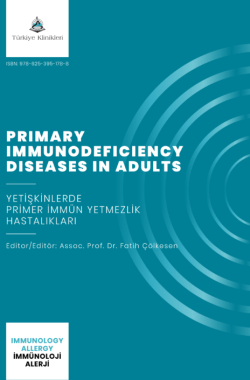Flow Cytometry for the Diagnosis of Primary Immunodeficiency Diseases
Recep EVCENa
aNecmettin Erbakan University Faculty of Medicine, Department of Internal Medicine, Division of Immunology and Allergy Diseases, Konya, Türkiye
Evcen R. Flow cytometry for the diagnosis of primary immunodeficiency diseases. Çölkesen F, ed. Primary Immunodeficiency Diseases in Adults. 1st ed. Ankara: Türkiye Klinikleri; 2024. p.75-82.
ABSTRACT
Flow cytometry is an indispensable tool in diagnosis of primary immunodeficiencies (PID). PIDs represent a significant health burden, associated with more than 485 different causative genes. Flow cytometry employs fluorescently labeled antibodies to measure cell size, granularity, and antigen expression levels. This article provides examples for some types of immunodeficiencies that can be diagnosed by flow cytometry. Diseases such as severe combined immunodeficiency, Bruton’s disease, chronic granulomatous disease, and common variable immunodeficiency can be diagnosed by flow cytometry. With advancing technology and discovery of new monoclonal antibodies, the role of flow cytometry in diagnosing and monitoring primary immunodeficiency is becoming more important.
Keywords: Flow cytometry; primary immunodeficiency; immunology
Kaynak Göster
Referanslar
- Zhang Q, Frange P, Blanche S, Casanova JL. Pathogenesis of infections in HIV-infected individuals: insights from primary immunodeficiencies. Curr Opin Immunol. 2017;48:122-33. [Crossref] [PubMed] [PMC]
- Tangye SG, Al-Herz W, Bousfiha A, Cunningham-Rundles C, Franco JL, Holland SM, et al. Human Inborn Errors of Immunity: 2022 Update on the Classification from the International Union of Immunological Societies Expert Committee. J Clin Immunol. 2022;42(7):1473-507. [Crossref] [PubMed] [PMC]
- Özdemir Ö, Karavaizoğlu Ç. Akım Sitometrinin İmmünolojik ve Allerjik Hastalıklarda Kullanımı. Asthma Allergy Immunol. 2016;14(3):117-28. [Crossref]
- Taneli F. Flow sitometri tekniği ve klinik laboratuvarlarda kullanımı. Türk Klinik Biyokimya Dergisi. 2007;5:75-82.
- Betters DM. Use of Flow Cytometry in Clinical Practice. J Adv Pract Oncol. 2015;6(5):435-40. [Crossref] [PubMed] [PMC]
- Dunphy CH. Applications of flow cytometry and immunohistochemistry to diagnostic hematopathology. Arch Pathol Lab Med. 2004;128(9):1004-22. [Crossref] [PubMed]
- Verbsky J, Routes MR. Flow cytometry for the diagnosis of primary immunodeficiencies. 2021. [Accessed date: July 7, 2021]. Access link: [Link]
- McKinnon KM. Flow Cytometry: An Overview. Curr Protoc Immunol. 2018;120:5.1.1-5.1.11. [Crossref] [PubMed] [PMC]
- Notarangelo LD. Primary immunodeficiencies. J Allergy Clin Immunol. 2010;125(2 Suppl 2):S182-94. [Crossref] [PubMed]
- Bonilla FA, Barlan I, Chapel H, Costa-Carvalho BT, Cunningham-Rundles C, de la Morena MT, et al. International Consensus Document (ICON): Common Variable Immunodeficiency Disorders. J Allergy Clin Immunol Pract. 2016;4(1):38-59. [Crossref] [PubMed] [PMC]
- Warnatz K, Schlesier M. Flowcytometric phenotyping of common variable immunodeficiency. Cytometry B Clin Cytom. 2008;74(5):261-71. [Crossref] [PubMed]
- van der Burg M, van Zelm MC, Driessen GJ, van Dongen JJ. New frontiers of primary antibody deficiencies. Cell Mol Life Sci. 2012;69(1):59-73. [Crossref] [PubMed] [PMC]
- O'Gorman MR, Zaas D, Paniagua M, Corrochano V, Scholl PR, Pachman LM. Development of a rapid whole blood flow cytometry procedure for the diagnosis of X-linked hyper-IgM syndrome patients and carriers. Clin Immunol Immunopathol. 1997;85(2):172-81. [Crossref] [PubMed]
- Bleesing JJ, Brown MR, Straus SE, Dale JK, Siegel RM, Johnson M, et al. Immunophenotypic profiles in families with autoimmune lymphoproliferative syndrome. Blood. 2001;98(8):2466-73. [Crossref] [PubMed]
- Marsh RA, Bleesing JJ, Filipovich AH. Using flow cytometry to screen patients for X-linked lymphoproliferative disease due to SAP deficiency and XIAP deficiency. J Immunol Methods. 2010;362(1-2):1-9. [Crossref] [PubMed] [PMC]
- Georgiev P, Charbonnier LM, Chatila TA. Regulatory T Cells: the Many Faces of Foxp3. J Clin Immunol. 2019;39(7):623-40. [Crossref] [PubMed] [PMC]
- Liu W, Putnam AL, Xu-Yu Z, Szot GL, Lee MR, Zhu S, et al. CD127 expression inversely correlates with FoxP3 and suppressive function of human CD4+ T reg cells. J Exp Med. 2006;203(7):1701-11. [Crossref] [PubMed] [PMC]
- Holland SM. Chronic granulomatous disease. Clin Rev Allergy Immunol. 2010;38(1):3-10. [Crossref] [PubMed]

